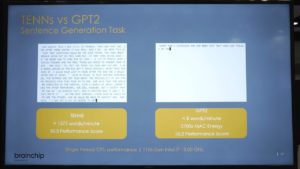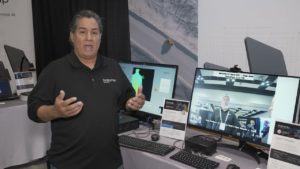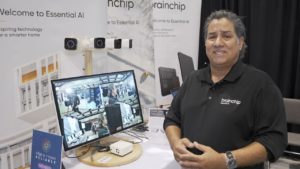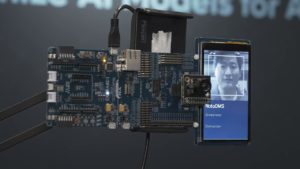Resources
In-depth information about the edge AI and vision applications, technologies, products, markets and trends.
The content in this section of the website comes from Edge AI and Vision Alliance members and other industry luminaries.
All Resources

Cadence Demonstration of an Imaging Radar Applications on the Tensilica ConnX B10 DSP
Amol Borkar, Director of Product Marketing for Cadence Tensilica DSPs and Automotive Segment Director, demonstrates the company’s latest edge AI and vision technologies and products at the 2024 Embedded Vision Summit. Specifically, Borkar demonstrates the

The Semiconductor Foundry Industry: Negotiating Troubled Waters
This market research report was originally published at the Yole Group’s website. It is reprinted here with the permission of the Yole Group. While the semiconductor foundry industry is facing many challenges, it is on

Quadric’s 3rd Generation Chimera GPNPU Product Family Expands to 864 TOPs, Adds Automotive-grade Safety Enhanced Versions
Chimera QC Series GPNPUs add more configurability, scales single cores to over 100 TOPs New multicore cluster QC-M family scales up to 864 TOPs Compute density increases TOPs/mm2 up to 2.7X greater than previous generation Adds

Roboshuttles and Autonomous Buses 2024-2044: Technologies, Trends, Forecasts
For more information, visit https://www.idtechex.com/en/research-report/roboshuttles-and-autonomous-buses-2024-2044-technologies-trends-forecasts/1020. Global Roboshuttles and Autonomous Buses sales revenue is to exceed US$67 billion by 2044. Roboshuttles and Autonomous Buses – US, EU, and Chinese market, key players, trends, safety, regulations, industry

Mission NIMpossible: Decoding the Microservices That Accelerate Generative AI
This blog post was originally published at NVIDIA’s website. It is reprinted here with the permission of NVIDIA. Run generative AI NVIDIA NIM microservices locally on NVIDIA RTX AI workstations and NVIDIA GeForce RTX systems.

BrainChip Demonstration of the Power of Temporal Event-based Neural Networks (TENNs)
Todd Vierra, Vice President of Customer Engagement at BrainChip, demonstrates the company’s latest edge AI and vision technologies and products at the 2024 Embedded Vision Summit. Specifically, Vierra demonstrates the efficient processing of generative text

BrainChip Demonstration of Analyzing Head Pose, Eye Gaze and Emotion with Human Behavior AI
Todd Vierra, Vice President of Customer Engagement at BrainChip, demonstrates the company’s latest edge AI and vision technologies and products at the 2024 Embedded Vision Summit. Specifically, Vierra demonstrates how BrainChip’s Akida AKD1000 neuromorphic processor

BrainChip Demonstration of Neuromorphic AI in a Compact Form Factor
Todd Vierra, Vice President of Customer Engagement at BrainChip, demonstrates the company’s latest edge AI and vision technologies and products at the 2024 Embedded Vision Summit. Specifically, Vierra demonstrates inference on the edge using visual

Axelera AI Demonstration of the High Performance Achievable with the Metis AIPU
Bram Verhoef, Co-founder of Axelera AI, demonstrates the company’s latest edge AI and vision technologies and products at the 2024 Embedded Vision Summit. Specifically, Verhoef demonstrates the high computer vision performance that can be achieved
Technologies

The Advanced Packaging Industry: Geopolitics is Moving the Pieces On the Chessboard
This market research report was originally published at the Yole Group’s website. It is reprinted here with the permission of the Yole Group. New plants, emerging outsourced semiconductor assembly and test (OSAT), and new consortia are changing the dynamics of the supply chain. OUTLINE The advanced packaging (AP) market is expected to have a CAGR23-29

Allegro DVT Launches The Industry’s First Real-time VVC/H.266 Encoder IP
Grenoble – July 16 – Allegro DVT, the leading provider of video encoding and decoding semiconductor IP solutions, today announced the availability of its E320 video encoder IP which supports the latest VVC/H.266 codec. Versatile Video Coding (VVC) is the latest video compression standard being developed by the Joint Video Experts Team (JVET), a partnership between

Nota AI Demonstration of Revolutionizing Driver Monitoring Systems
Tae-Ho Kim, CTO and Co-founder of Nota AI, demonstrates the company’s latest edge AI and vision technologies and products at the 2024 Embedded Vision Summit. Specifically, Kim demonstrates Nota DMS, his company’s state-of-the-art driver monitoring system. The solution enhances driver safety by monitoring attention and detecting drowsiness in real-time. Cutting-edge AI techniques make Nota DMS
Applications

Nota AI Demonstration of Revolutionizing Driver Monitoring Systems
Tae-Ho Kim, CTO and Co-founder of Nota AI, demonstrates the company’s latest edge AI and vision technologies and products at the 2024 Embedded Vision Summit. Specifically, Kim demonstrates Nota DMS, his company’s state-of-the-art driver monitoring system. The solution enhances driver safety by monitoring attention and detecting drowsiness in real-time. Cutting-edge AI techniques make Nota DMS

Nextchip Demonstration of Its Vision Professional ISP Optimization for Computer Vision
Sophie Jeon, Global Strategy Marketing Manager at Nextchip, demonstrates the company’s latest edge AI and vision technologies and products at the 2024 Embedded Vision Summit. Specifically, Jeon demonstrates her company’s expertise in optimizing ISPs for computer vision by comparing the tuning technologies used for human vision and machine vision applications.

Steering a Revolution: Optimized Automated Driving with Heterogeneous Compute
This blog post was originally published at Qualcomm’s website. It is reprinted here with the permission of Qualcomm Qualcomm Technologies’ latest whitepaper navigates the advantages of Snapdragon Ride Solutions based on heterogeneous compute SoCs. As the automotive industry continues to progress toward automated driving, advanced driver assistance systems (ADAS) are in high demand. These systems
Functions

Nota AI Demonstration of Revolutionizing Driver Monitoring Systems
Tae-Ho Kim, CTO and Co-founder of Nota AI, demonstrates the company’s latest edge AI and vision technologies and products at the 2024 Embedded Vision Summit. Specifically, Kim demonstrates Nota DMS, his company’s state-of-the-art driver monitoring system. The solution enhances driver safety by monitoring attention and detecting drowsiness in real-time. Cutting-edge AI techniques make Nota DMS

Nextchip Demonstration of Its Vision Professional ISP Optimization for Computer Vision
Sophie Jeon, Global Strategy Marketing Manager at Nextchip, demonstrates the company’s latest edge AI and vision technologies and products at the 2024 Embedded Vision Summit. Specifically, Jeon demonstrates her company’s expertise in optimizing ISPs for computer vision by comparing the tuning technologies used for human vision and machine vision applications.

Nextchip Demonstration of the APACHE5 ADAS SoC
Sophie Jeon, Global Strategy Marketing Manager at Nextchip, demonstrates the company’s latest edge AI and vision technologies and products at the 2024 Embedded Vision Summit. Specifically, Jeon demonstrates her company’s APACHE5 ADAS SoC. APACHE5 is ready for market with an accompanying SDK, and has passed all qualifications for production such as PPAP (the Production Part

